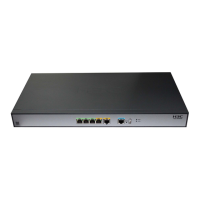16
Step Command Remarks
12. Set the maximum number of
retransmission attempts for
frames larger than the RTS
threshold.
long-retry threshold
count
Optional.
By default, the long retry threshold
is 4.
13. Specify the maximum number of
attempts to transmit a frame
shorter than the RTS threshold.
short-retry
threshold
count
Optional.
By default, the short retry
threshold is 7.
14. Specify the interval for the AP to
hold received packets.
max-rx-duration
interval
Optional.
By default, the interval is 2000
milliseconds.
15. Configure collision avoidance
• Specify the request to
send (RTS) threshold
length.
rts-threshold size
• Specify a collision
avoidance mechanism.
protection-mode
{ cts-to-self | rts-cts }
• Optional.
By default, the RTS threshold
is 2346 bytes.
• Optional.
By default, the collision
avoidance mechanism is
CTS-to-Self.
Configuring 802.11n
The following matrix shows the feature and router compatibility:
Featur
e
MSR80
0
MSR
900
MSR90
0-E
MSR
930
MSR
20-1X
MSR 20 MSR 30 MSR 50
802.11n
Available
for
MSR800
-W and
MSR800
-10-W.
No
Availabl
e for
MSR90
0-E-W.
Available
for MSR
930-W,
MSR
930-W-G
U, and
MSR
930-W-G
T.
Available
for routers
with a
SIC_WLA
N module
that
supports
802.11n
Available
for
routers
with a
SIC_WLA
N module
that
supports
802.11n
Available
for
routers
with a
SIC_WLA
N module
that
supports
802.11n
Available
for
routers
with a
SIC_WL
AN
module
that
supports
802.11n
As the next generation wireless LAN technology, 802.11n supports both 2.4-GHz and 5-GHz bands.
It provides higher throughput by using the following methods:
• Increasing bandwidth: 802.11n can bond two adjacent 20-MHz channels together to form a
40-MHz channel. During data forwarding, the two 20-MHz channels can work separately with
one acting as the primary channel and the other acting as the secondary channel or working
together as a 40-MHz channel. This provides a simple way of doubling the data rate.
• Improving channel utilization through the following ways:
{ 802.11n introduces the A-MPDU frame format. By using only one PHY header, each
A-MPDU can accommodate multiple MPDUs which have their PHY headers removed. This
reduces the overhead in transmission and the number of ACK frames to be used, and
improves network throughput.
{ Similar with MPDU aggregation, multiple MSDU can be aggregated into a single A-MSDU.
This reduces the MAC header overhead and improves MAC layer forwarding efficiency.
{ To improve physical layer performance, 802.11n introduces the short GI function, which
shortens the GI interval of 800 ns in 802.11a/g to 400 ns. This can increase the data rate by
10 percent.

